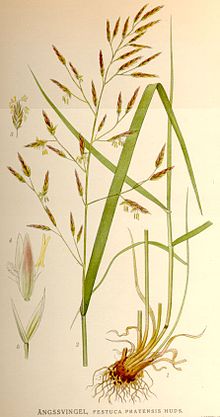Lolium pratense: Difference between revisions
ce |
Creates taxonomy section |
||
| Line 28: | Line 28: | ||
It has a short, blunt [[ligule]] compared to other grasses 1 mm high. The leaves are bright green and up to 4 mm across.<ref>Grasses by C E Hubbard, 1978, published by Penguin books</ref> |
It has a short, blunt [[ligule]] compared to other grasses 1 mm high. The leaves are bright green and up to 4 mm across.<ref>Grasses by C E Hubbard, 1978, published by Penguin books</ref> |
||
==Taxonomy== |
|||
This species was originally included within the genus ''[[Festuca]]'', owing to the similarity of the flowers and inflorescences. However, there has been much debate since 1898 about its relationship to the genus ''[[Lolium]]'', largely because of hybridization with ''[[Lolium perenne]]'' (species in separate genera are far less likely to form hybrids than those within the same genus).<ref name=Soreng>{{Cite journal |last=Soreng |first=R.J. |last2=Terrell |first2=E.E. |date=1997 |title=Taxonomic notes on ''Schedonorus'', a segregate genus from ''Festuca'' or ''Lolium'', with a new nothogenus, x ''Schedololium'', and new combinations |url=https://biostor.org/reference/63227 |journal=Phytologia |volume=83 |issue=2 |pages=85-88}}</ref><ref name=Darbyshire>{{Cite journal |last=Darbyshire |first=S.J. |date=1993 |title=Realignment of ''Festuca'' Subgenus ''Schedonorus'' with the Genus ''Lolium'' (Poaceae) |url=https://www.jstor.org/stable/3391460 |journal=Novon |volume=3 |pages=239-243}}</ref> Recent DNA studies have shown that it should indeed be considered a ryegrass (''Lolium'') rather than a fescue (''Festuca'') because these species are more closely related to each other, despite the fact that ryegrasses have inflorescences of spikes rather than racemes.<ref name=Cheng>{{Cite journal |last=Cheng |first=Y. |last2=Zhou |first2=K. |last3=Humphreys |first3=M.W. |last4=Harper |first4=J.A. |last5=Ma |first5=X. |last6=Zhang |first6=X. |last7=Yan |first7=H. |last8=Huang |first8=L. |date=2016 |title=Phylogenetic Relationships in the ''Festuca-Lolium'' Complex (Loliinae; Poaceae): New Insights from Chloroplast Sequences |journal=Frontiers in Ecology and Evolution |volume=4 |issue=89 |doi=10.3389/fevo.2016.00089}}</ref><ref name=Banfi>{{Cite journal |last=Banfi |first=E. |last2=Galasso |first2=G. |last3=Foggi |first3=B. |last4=Kopecký |first4=D. |last5=Ardenghi |first5=N.M.G. |date=2017 |title=From ''Schedonorus'' and ''Micropyropsis'' to ''Lolium'' (Poaceae: Loliinae): new combinations and typifications |url=https://doi.org/10.12705/663.11 |journal=Taxon |volume=66 |issue=3 |pages=708-717 |via=Wiley Online Library}}</ref> |
|||
==Gallery== |
==Gallery== |
||
Revision as of 11:14, 10 February 2024
| Meadow fescue | |
|---|---|

| |
| Scientific classification | |
| Kingdom: | Plantae |
| Clade: | Tracheophytes |
| Clade: | Angiosperms |
| Clade: | Monocots |
| Clade: | Commelinids |
| Order: | Poales |
| Family: | Poaceae |
| Subfamily: | Pooideae |
| Genus: | Festuca |
| Species: | F. pratensis
|
| Binomial name | |
| Festuca pratensis | |
| Synonyms | |
Festuca pratensis, the meadow fescue,[1] is a perennial species of grass, which is often used as an ornamental grass in gardens, and is also an important forage crop.
It grows in meadows, roadsides, old pastures, and riversides on moist, rich soils, especially on loamy and heavy soils.
It is a tall, tufted grass similar to the tall fescue, F. arundinacea. F. pratensis differs by having only 2 spikelets on the smaller branch at the lowest panicle node and by having minute hairs on the auricles. It can hybridise with Lolium perenne and Lolium multiflorum.[2]
Description
It is a perennial bunchgrass, (i.e. grows in tufts), which grows 30–120 cm (12–47 in), flowering from June until August. The panicles are green to purplish. The spikelets have 5 to 14 flowers.
It has a short, blunt ligule compared to other grasses 1 mm high. The leaves are bright green and up to 4 mm across.[3]
Taxonomy
This species was originally included within the genus Festuca, owing to the similarity of the flowers and inflorescences. However, there has been much debate since 1898 about its relationship to the genus Lolium, largely because of hybridization with Lolium perenne (species in separate genera are far less likely to form hybrids than those within the same genus).[4][5] Recent DNA studies have shown that it should indeed be considered a ryegrass (Lolium) rather than a fescue (Festuca) because these species are more closely related to each other, despite the fact that ryegrasses have inflorescences of spikes rather than racemes.[6][7]
Gallery
-
Festuca pratensis
-
The base of the leaf
-
Festuca pratensis
-
Festuca pratensis
References
- Pink, A. (2004). Gardening for the Million. Project Gutenberg Literary Archive Foundation.
- ^ BSBI List 2007 (xls). Botanical Society of Britain and Ireland. Archived from the original (xls) on 2015-06-26. Retrieved 2014-10-17.
- ^ Collins Pocket Gude Grasses, Sedges, Rushes & Ferns Of Britain and Northern Europe, 1995, 0 00 219136 9
- ^ Grasses by C E Hubbard, 1978, published by Penguin books
- ^ Soreng, R.J.; Terrell, E.E. (1997). "Taxonomic notes on Schedonorus, a segregate genus from Festuca or Lolium, with a new nothogenus, x Schedololium, and new combinations". Phytologia. 83 (2): 85–88.
- ^ Darbyshire, S.J. (1993). "Realignment of Festuca Subgenus Schedonorus with the Genus Lolium (Poaceae)". Novon. 3: 239–243.
- ^ Cheng, Y.; Zhou, K.; Humphreys, M.W.; Harper, J.A.; Ma, X.; Zhang, X.; Yan, H.; Huang, L. (2016). "Phylogenetic Relationships in the Festuca-Lolium Complex (Loliinae; Poaceae): New Insights from Chloroplast Sequences". Frontiers in Ecology and Evolution. 4 (89). doi:10.3389/fevo.2016.00089.
{{cite journal}}: CS1 maint: unflagged free DOI (link) - ^ Banfi, E.; Galasso, G.; Foggi, B.; Kopecký, D.; Ardenghi, N.M.G. (2017). "From Schedonorus and Micropyropsis to Lolium (Poaceae: Loliinae): new combinations and typifications". Taxon. 66 (3): 708–717 – via Wiley Online Library.
External links
 Media related to Festuca pratensis at Wikimedia Commons
Media related to Festuca pratensis at Wikimedia Commons- "Festuca pratensis". Plants for a Future.
- "Festuca pratensis". Calflora. Berkeley, California: The Calflora Database.
- Festuca pratensis in the CalPhotos photo database, University of California, Berkeley




